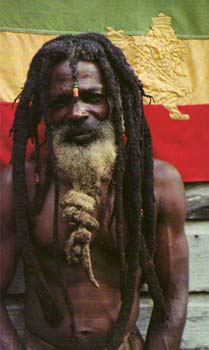

It is very commonplace to see Rastas with dreadlocks. It is important to keep in mind, however, that not all Rastas have locks, and not all locksmen are Rastas. It is just a common characteristic among Rastas, symbolizing deep devotion to the Holy God. Rastas view locks as having biblical origin. In the Old Testament, there are many references to "locks."
Rastas relate locks to the Nazarite vow described in the earlier parts of the Old Testament.
All the days of the vow of the separation there shall no razor come upon his head until the days are fulfilled for which he separated himself to the Lord, he shall be holy, and shall let the locks of the hair of his head grow. (Numbers 6:5)
Samson is the classic example of this relation. Samson's mother was visited by Jah and was told:
For, lo thou shall conceive, and bear a son; and no razor shall come on his head: for the child shall be a nazarite unto God from the womb: and he shall begin to deliver Israel out of the hands of the Philistines. (Judges 13:5)
As he grew, Samson possessed extraordinary strength. He then married Delilah, and because she would not believe him when he spoke about the reason for his locks,
...she made him to sleep upon her knee; and she called for a man, and she caused him to shave off the seven locks of his head; and she began to afflict him, and his strength went from him. (Judges 16:19)
From this verse, one can see how Rastas have determined that dreadlocks are part of the holy Nazarite vow, as Samson has seven locks. One can also see the mythical relation to locks as a source of incredible strength and power. Even after his head had been shaved by his deceitful wife Delilah and had only a small amount of hair, he was able to topple the two pillars of the house and destroy the Philistines.

Samson has become a sort of hero for Rastas as upholding strength and righteousness, as well as having natty locks. Many Rastas take the Nazarite vow, swearing not to cut (kill) hair, and many include abstaining from combing in this vow. Rastas are also advocates of living naturally, and letting one's hair take its natural course is another part of what is called Ital (Vital).
Another reason that Rastas wear locks is that locks are a semi-permanent symbol signifying their devotion to Jah. Locks take time to grow, and one can't just change their hairstyle without shaving all of his hair. Therefore, it is a symbol of a commitment.
Another possible reason for the adoption of dreadlocks as a religious symbol is the wearing of locks by Indian holy men called Sadhus (left). After the slaves were released from Jamaica, the white plantation owners imported Indian cheap laborors. With these new immigrants came their own culture, equipped with marijuana use and dreadlocks. It is also possible that different African groups, namely Ethiopian warriors, influenced early Rasta leaders to adopt the wearing of locks.